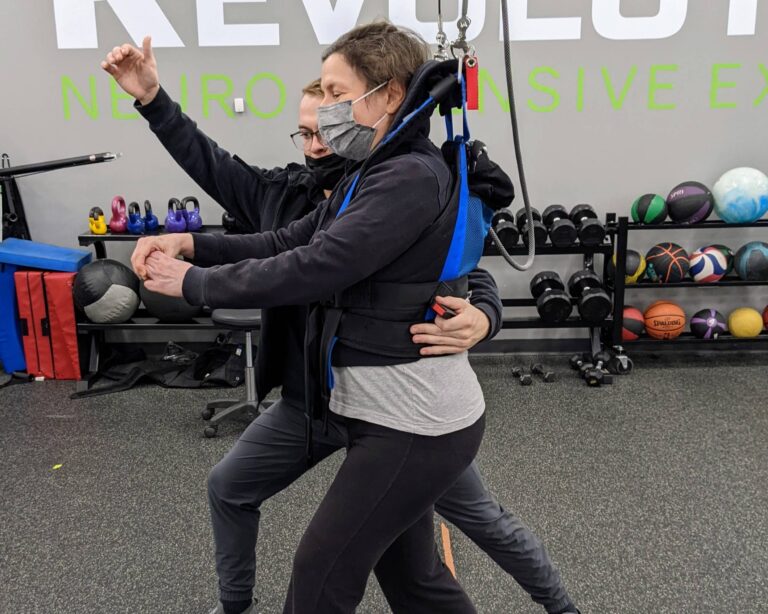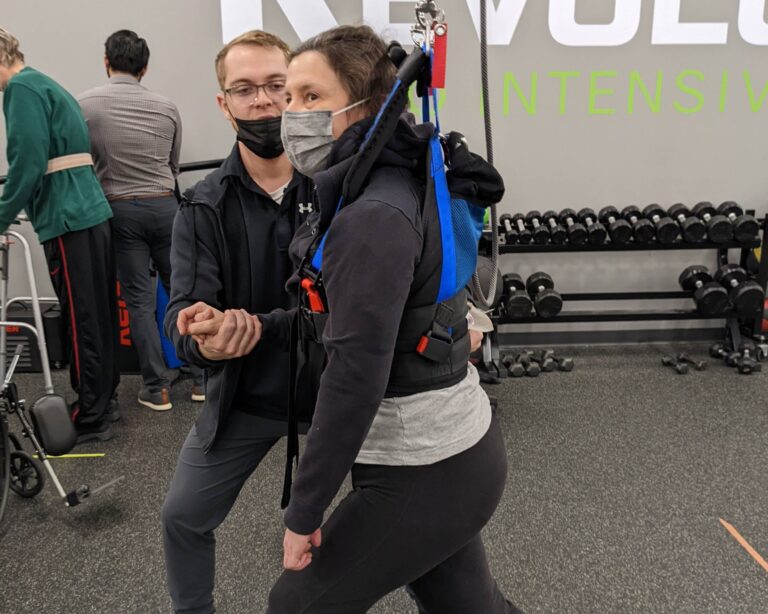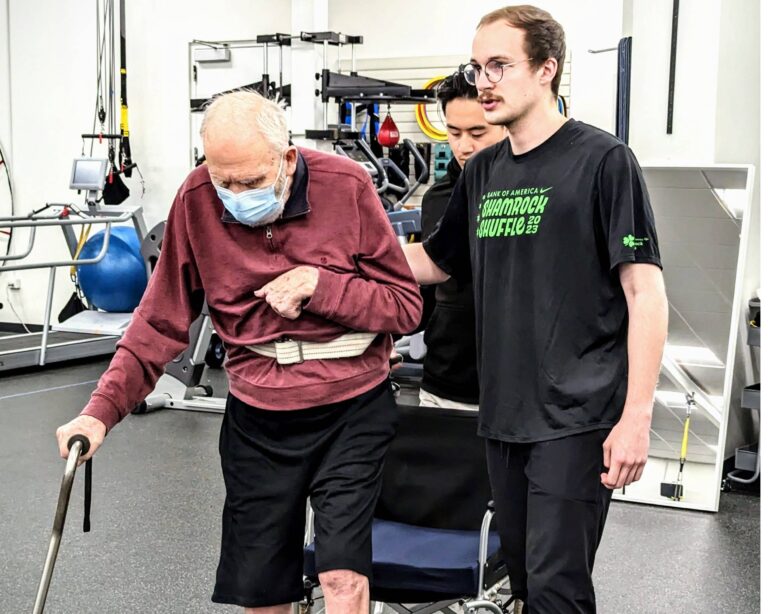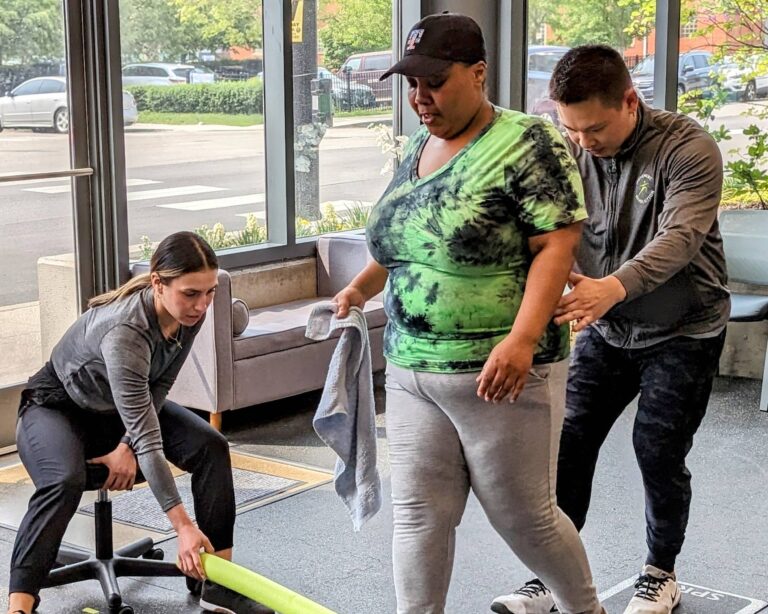At Movement Revolution, our Neuro Exercise Specialists work closely with other healthcare professionals, such as physical therapists and neurologists, to ensure a coordinated and comprehensive approach to stroke rehabilitation, and that our programs pick up where therapy leaves off. Our team has considerable expertise regarding the neuroplasticity of the brain and how it can be harnessed to improve movement and function and can implement safe and effective exercise programs for our members. We are committed to staying up to date with the latest research and best practices in stroke rehabilitation and continuously seek to improve our skills and knowledge.
Stroke Exercise Program Highlights
- Expert, trained staff for all ability levels
- Specialized equipment including a body weight support track system that enables our clients to practice walking without the risk of falling
- A variety of exercise services and programs
- Personalized One-on-One Programs
- Group Exercise Classes
- Rock Steady Boxing Chicago Programs
Did you know…
Studies show that continued exercise post-stroke is one of the most important factors in limiting secondary conditions, additional strokes and improving the overall quality of life. Exercise interventions are beneficial and can enhance functional ability at any point in stroke recovery.
What to Expect from Our Stroke Exercises
Our Neuro Exercise Specialists use various techniques and tools, such as neuroplasticity-based exercises, high-intensity interval training and motor-learning principles, to help clients retrain their brains and bodies to function more effectively.
Some common goals for individuals who have had a stroke that Movement Revolution may help you work on include:
Improving motor function: A stroke can cause various motor symptoms, such as weakness, spasticity and reduced coordination.
Improving balance and coordination: A stroke can affect your balance and coordination, increasing your risk of falls.
Improving strength and flexibility: A stroke can lead to weakness and reduced flexibility, making it difficult to perform daily activities.
Improving cardiovascular health: Exercise can help improve cardiovascular health, which is important for overall health and well-being.
Improving mood and quality of life: A stroke can be challenging and impact your mood and overall quality of life.
The specific goals and treatment plan you will work on will depend on your unique situation and the goals you want to achieve.
Frequently Asked Questions
The best exercise for stroke survivors can vary depending on the individual’s specific needs, abilities and limitations. However, here are some types of exercise that may be beneficial for stroke recovery:
- Aerobic exercise: Aerobic exercises, such as walking, cycling or swimming, can help improve cardiovascular health, increase endurance and promote overall fitness. Aerobic exercise can also improve mood and cognitive function, both of which may be impacted by stroke.
- Strength training: Strength training exercises can help improve muscle strength and endurance, which can help with activities of daily living and reduce the risk of falls. Resistance bands or weights may be used for strength training.
- Range of motion and stretching exercises: Range of motion and stretching exercises can help improve flexibility and range of motion, reduce muscle stiffness and spasticity, and improve overall mobility.
- Balance and coordination exercises: Balance and coordination exercises can help improve balance and reduce the risk of falls. Exercises may include standing on one leg, practicing shifting weight from one foot to the other, and walking on a variety of surfaces or uneven terrain.
It is important to work with a healthcare professional, such as a physical therapist or a Neuro Exercise Specialist, to develop an exercise program that is safe and appropriate for your needs and abilities. We will also monitor your progress and adjust your program as needed to support your recovery goals.
If you have had a stroke, it is important to work with a healthcare professional, such as a physical therapist or a Neuro Exercise Specialist, to determine what types of exercise will be safe and appropriate for your needs and abilities. Here are some steps you can take to find the best exercise program for you:
- Speak with your healthcare provider: Your healthcare provider can help you understand what types of exercise will be safe and effective for your specific needs and abilities. They can also refer you to a physical therapist or other healthcare professional who can work with you to develop an exercise program tailored to your needs.
- Consider your goals: Think about what you hope to achieve through exercise. Do you want to improve your strength, endurance, balance or mobility? Are you hoping to reduce your risk of falls or improve your overall fitness? By identifying your goals, you can work with your specialist to develop an exercise program tailored to meet those goals.
- Start slowly and gradually increase: When starting an exercise program after a stroke, it is important to start slowly and gradually increase the intensity and duration of your workouts. This can help you avoid injury or overexertion and can help you build your endurance over time.
- Be consistent: Consistency is key when it comes to exercise. Aim to exercise regularly, even if it is just a few minutes each day. Over time, this can help you build strength, endurance and overall fitness.
By working with a healthcare professional, setting goals, starting slow, listening to your body and being consistent, you can find an exercise program that is safe, effective and tailored to your needs and abilities after a stroke.
It is common to feel nervous or apprehensive about starting an exercise program after a stroke. However, it is important to remember that any amount of exercise, no matter how small, can have significant benefits for your physical and mental health. Here are some tips to help you overcome your nerves and get started with exercise after a stroke:
- Start with simple movements: Begin with simple movements, such as stretching, walking or seated exercises and gradually increase the intensity and duration of your workouts as your strength and endurance improve.
- Work with a professional: Consider working with a physical therapist or a Neuro Exercise Specialist who can help you develop an exercise program tailored to your needs and abilities. They can also provide guidance on proper form and technique and help you modify exercises if needed.
- Set realistic goals: Start with small, achievable goals, such as walking for five minutes a day and gradually increase the duration and intensity of your workouts as you improve. This can help you build confidence and stay motivated.
- Listen to your body: Pay attention to how your body responds to exercise. If you experience pain, dizziness or other symptoms, stop the exercise and speak with your healthcare provider or personal trainer.
- Celebrate your progress: Celebrate your progress, no matter how small it may seem. Every little bit of exercise can have significant benefits for your physical and mental health.
Remember, it is never too late to start exercising after a stroke. With patience, perseverance and the right support, you can find a safe, effective exercise program tailored to your needs and abilities.
It is understandable to be concerned about the cost of exercise services. Still, it is important to consider the potential benefits of exercise for your overall health and recovery after a stroke. Research has shown that exercise can improve physical function, mobility and quality of life in individuals who have had a stroke. Exercise can also help prevent secondary complications such as muscle weakness, contractures and pressure ulcers.
Investing in your health and recovery after a stroke can help improve your overall quality of life and potentially reduce long-term healthcare costs associated with complications or disability.
In general, exercise is considered safe and beneficial for most people who have had a stroke. Still, it is important to consult with your healthcare provider or a certified exercise specialist before starting any exercise program to determine what types of exercise are safe and appropriate for your needs and level of physical function.
Some individuals may experience discomfort or increased symptoms during or after exercise, particularly if the exercise is too intense or involves movements or positions that are difficult for them. However, this does not necessarily mean that exercise is worsening their condition. It may simply indicate that the exercise needs to be modified or that they need to progress more gradually.
It is important to monitor your symptoms during and after exercise and to speak with your healthcare provider or exercise specialist if you experience any unusual symptoms or have concerns about your exercise program. They can help you modify your exercise program as needed to ensure that it is safe and effective for your needs.
The intensity level of exercise after a stroke should be determined by your healthcare provider or a certified exercise specialist, as it depends on your needs and goals, as well as your level of physical function and any other medical conditions you may have. In general, it is important to start with a low to moderate-intensity exercise program, gradually increasing the intensity as your physical function improves. This can help reduce the risk of injury or other complications and ensure that you are making progress toward your goals.
It is also important to listen to your body and not push yourself too hard, especially if you are experiencing pain, discomfort or other symptoms. It is normal to feel fatigued or sore after exercise. Still, if you are experiencing any unusual symptoms or have concerns about your exercise program, it is important to discuss them with your healthcare provider or exercise specialist.
The answer to this question depends on the severity of your stroke, the extent of your physical limitations and your needs and goals. In general, it is recommended that stroke survivors work with a healthcare professional or a certified exercise specialist to develop an appropriate exercise program that is safe and effective.
An exercise program for stroke survivors should be tailored to your specific needs and goals, taking into consideration your physical limitations and any other medical conditions you may have. Depending on your level of physical function and any potential risks, you may need assistance or supervision from a healthcare professional or exercise specialist to perform certain exercises safely.
Stroke is not a progressive disease but rather a sudden onset condition that results from a disruption in blood flow to the brain. However, exercise can be beneficial for stroke recovery and management in several ways. Regular exercise can help improve physical function and mobility, reduce the risk of future strokes and promote overall health and well-being. Exercise has also been shown to improve cognitive function and reduce the risk of depression and anxiety in stroke survivors.
While exercise cannot slow down the progression of a stroke, it can help improve your overall health and well-being and potentially reduce your risk of experiencing additional health problems related to your stroke. It is important to work with your healthcare provider to develop a safe and effective exercise program tailored to your needs and goals. They can help you determine the types and intensity of exercise that are appropriate for you and monitor your progress over time.
No, exercise cannot replace medication for stroke. Medication prescribed by your healthcare provider is an essential part of stroke recovery and management, and it is important to take it as directed.
However, exercise can complement medication and other treatments for stroke by improving physical function, reducing the risk of future strokes, and promoting overall health and well-being. In some cases, exercise may also help reduce the dosage or number of medications needed to manage stroke risk factors such as high blood pressure or diabetes.
It is important to work with your healthcare provider to develop a comprehensive treatment plan that includes both medication and exercise, as well as any other recommended treatments or therapies. Together, you can create a plan tailored to your needs and goals that promotes the best possible outcomes for your recovery from stroke.
Movement Revolution can provide a comprehensive, multidisciplinary approach to your recovery post-stroke, with a focus on improving function, reducing symptoms and enhancing the quality of life. Here are some ways we can help:
- Individualized exercise programs: Movement Revolution may work with you to develop an individualized exercise program tailored to your specific needs and goals. This can include exercises to improve strength, endurance, balance and flexibility.
- Specialized equipment: Movement Revolution has specialized equipment designed to help individuals who have had a stroke.
- Skilled professionals: Movement Revolution has skilled professionals who can provide guidance and support to help you progress and achieve your goals.
- Community support: Movement Revolution can provide a supportive community of individuals who are going through similar experiences. This can provide emotional support and motivation to help you stay committed to your exercise program.
- Continuity of care: Movement Revolution can also work with your healthcare team to ensure continuity of care and help you transition back to your home or community-based exercise program.
Overall, Movement Revolution can provide a safe and supportive environment to help you improve your physical function and quality of life after a stroke.
Your Roadmap to Living Stronger
When you become a part of Movement Revolution, you begin with a comprehensive movement evaluation utilizing the latest tools and technology. Each assessment is unique to your diagnosis and is used to establish your personal goals, objectives, and desired physical outcomes.
Want to connect with us, or request an assessment? Complete the form below, and a member of our team will be in touch shortly!






